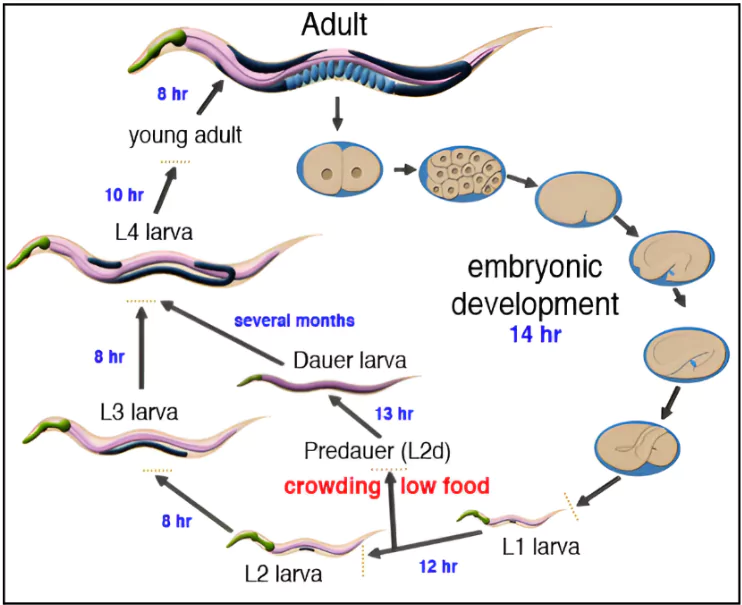The 2024 Nobel Prize winner (Physiology or Medicine) Molecular biologist Gary Ruvkun, highlighted the contributions of the tiny worm Caenorhabditis elegans, which has been central to at least four Nobel Prizes in 2002, 2006, 2008, and 2024.
| Year |
Nobel Prize Winner(s) |
Key Contribution |
| 2002 |
Sydney Brenner, H. Robert Horvitz, John E. Sulston |
Discovery of genetic regulation of organ development and programmed cell death (apoptosis) using C. elegans as a model organism. |
| 2006 |
Andrew Z. Fire, Craig C. Mello |
Discovery of RNA interference (RNAi), a mechanism for regulating gene expression, which has significant implications in biology and medicine. |
| 2008 |
Harald zur Hausen, Françoise Barré-Sinoussi, Luc Montagnier |
Discovery of the role of human papillomavirus (HPV) in cervical cancer and the identification of HIV as the cause of AIDS. |
| 2024 |
Victor Ambros and Gary Ruvkun |
Discovery of microRNA and its role in post-transcriptional gene regulation. They utilized C. elegans to understand fundamental biological processes. |
Click to Know: Nobel Prize 2024 Winners List
About Caenorhabditis elegans (C. elegans)

- Type: It is Microscopic nematode (roundworm) which Approximately 1 mm long normally lives in soil.
- Nematodes, also known as roundworms, are a diverse group of worms classified under the phylum Nematoda.
- Nematodes exist in various habitats, including soil, freshwater, marine environments, and as parasites in plants, animals, and humans.
- They can be grown in a petri-dish containing E. coli in the laboratory, as their natural diet is bacteria.
- Naming and Movement : Derived from the Latin word “elegans,” referring to the graceful, sinusoidal waves it creates while moving
- Historical Significance: Dr. Sydney Brenner is credited with popularizing C. elegans as a research model in laboratories worldwide.
Enroll now for UPSC Online Classes
Importance of C. elegans in Research
- Research Focus: Widely used to understand neuronal and molecular biology.
- Simplicity: Ideal for research due to its straightforward structure and genetic accessibility.
What are research models in laboratories?
A research model in a laboratory is a simplified representation of biological processes used for experimentation.
- Purpose: Helps understand complex biological systems.
- Types: Can be cellular, animal, or computer-based.
- Reproducibility: Facilitates repeatable experiments.
- Validity: Provides insights applicable to larger biological contexts.
- Examples: Common models include C. elegans, mice, and yeast.
|
- Genetic Milestones:
- First multicellular organism to have its full genome sequenced
- First to have its neural wiring fully mapped
C. elegans as a model for mitochondrial diseases
- C. elegans has orthologous genes to human mitochondrial disease genes, making it a useful model for studying these conditions.
- Gene suppression in C. elegans leads to developmental defects, such as failure to reach maturity or death.
- Partial suppression of specific mitochondrial genes in C. elegans paradoxically extends its lifespan.
- elegans as a model for immunology:
- C. elegans models the innate immune response using antimicrobial molecules like lectins and lysozymes.
- p38 MAPK signalling is crucial for C. elegans’ defence against Salmonella Typhimurium, with mutants showing higher susceptibility.
- C. elegans is also useful for studying bacterial behaviour, with S. Typhimurium virulence factors like PhoP/PhoQ being essential for infection establishment.
Check Out UPSC NCERT Textbooks From PW Store
Unique Biological Traits making it favourite subject in research
- Rapid Development:Grows from fertilised egg to an adult in 3–5 days
- Compact lifecycle facilitates ease of experimentation and observation
- Sexes: Two distinct sexes
- Hermaphrodite: Produces limited sperm, can reproduce by:
- Self-fertilisation
- Cross-fertilization (via mating with a male)
- Male: Transfers sperm to hermaphrodite during mating
- Cell Count: It has exactly 959 cells, each named and tracked throughout its life cycle — a highly manageable number compared to human cells
- Genetic Tractability: Provides insights into fundamental biological processes due to its simple anatomy and cell lineage mapping
![]() 22 Oct 2024
22 Oct 2024

